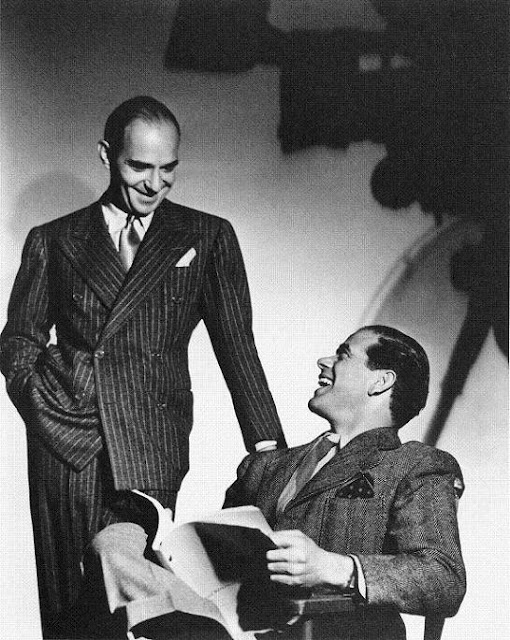 A lot of fans don't like Frank Capra, the director of films like "It Happened One Night," "Mr. Deeds Goes to Town" and "It's a Wonderful Life." I guess he's too sentimental for some people. That's a pity. His best films always feel directed and they always feel written, and that's no small achievement.
A lot of fans don't like Frank Capra, the director of films like "It Happened One Night," "Mr. Deeds Goes to Town" and "It's a Wonderful Life." I guess he's too sentimental for some people. That's a pity. His best films always feel directed and they always feel written, and that's no small achievement.A lot of the credit goes to his long-time collaborator, writer Robert Riskin. I just saw "Mr. Deeds" and I have a copy of the screenplay in front of me so I thought I'd pick a couple of pages and talk about what I like about them.
Synopsis of the sequence: Mr. deeds takes his girl to a restaurant where a bunch of writers make fun of him for being a greeting card poet. When he realizes what they're up to he stands up and gets mad.

Let me digress for a moment because the context of these pages is important. Immediately before the restaurant sequence people in a cramped, crowded car driving in the rain were frantically yelling, "Hurry! Hurry!" Capra fades to the dry and spacious restaurant interior where dreamy, romantic music is playing and the camera tracks past busy waiters and customers to Gary Cooper and Jean Arthur.The sequence is wonderful already, and nobody's even said anything yet!
I forgot to say that the restaurant is neat, beautiful and civilized but not gaudy. The film celebrates civilization. Capra (as he always does) fills the scene with a kazillion extras and the gypsy violin music is to die for. What a contrast to the frenzied shouts in the last sequence!
The cuts are incredible! The shots are clipped and have an avant-garde feeling but the gypsy violin and the friendly faces of the stars soothes over the drastic cuts and we hardly notice them.
So what does all this have to do with Riskin's script? Everything! The script allows the visuals and the ambient sound to carry the beginning of the sequence!!!! Nobody says, "Isn't this a beautiful restaurant?" The waiters don't talk to each other. The script knows how to be quiet! It's a cinematic script!
There's some terrific dialogue between Cooper and Arthur, and that part has it's own build and climax, then the wicked, big-city writers invite the couple over to their table.
The writers speak fast and furious and each taunts Deeds with his own style of speaking. The word music is incredible! Imagine that! The writer wrote this section with word music in mind! When has an animation writer ever done that? This whole part of the script is a set-piece to show off the sound of the human voice!
OK ,that takes us to the beginning of the script that I reproduced below.

Mr. Deeds gets mad and the word music shifts to oratory as he scolds. I love oratory! I read a how-to book that advised writers to avoid it...bad advice! Audiences love to hear the roar of the aroused (the right word?) lion!


Deeds punches everybody out and one of the writers apologizes and offers to take him and his date out on the town. This doesn't exactly move the story forward but the dialogue is beautifully written and the actor that delivered it did a tour de force job. He was able to do such a good job because the writer had the courage to write a literate and complex piece of word music for him.
I also call your attention to the fact that Riskin gave this beautiful performance piece to a non-essential actor who we hardly see again in the film. Animation story editors would delete set pieces like this without hesitation which is why the Deity will no doubt send them all to Hell someday. Screen writing is more akin to opera than to straight narrative, as Riskin rightly perceives.





































 Now adults on the other hand...like (ahem!) me...that's different.
Now adults on the other hand...like (ahem!) me...that's different. Adults are fine and noble chaps! They're good conversationalists. You can talk to an adult. You can reason with them! And the ideas! They have SUCH ideas!
Adults are fine and noble chaps! They're good conversationalists. You can talk to an adult. You can reason with them! And the ideas! They have SUCH ideas! I think the reason why kids' creativity is so over-rated is that they make bold drawings on art projects. Maybe that's because they don't have to pay for the pigments. If I were to think about making a bold, red background like the one above I'd be calculating the cost. Kids don't have to do that.
I think the reason why kids' creativity is so over-rated is that they make bold drawings on art projects. Maybe that's because they don't have to pay for the pigments. If I were to think about making a bold, red background like the one above I'd be calculating the cost. Kids don't have to do that.





 "Well here's my transportation now! It looks like that's all we have time for this week!"
"Well here's my transportation now! It looks like that's all we have time for this week!"